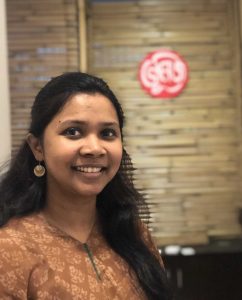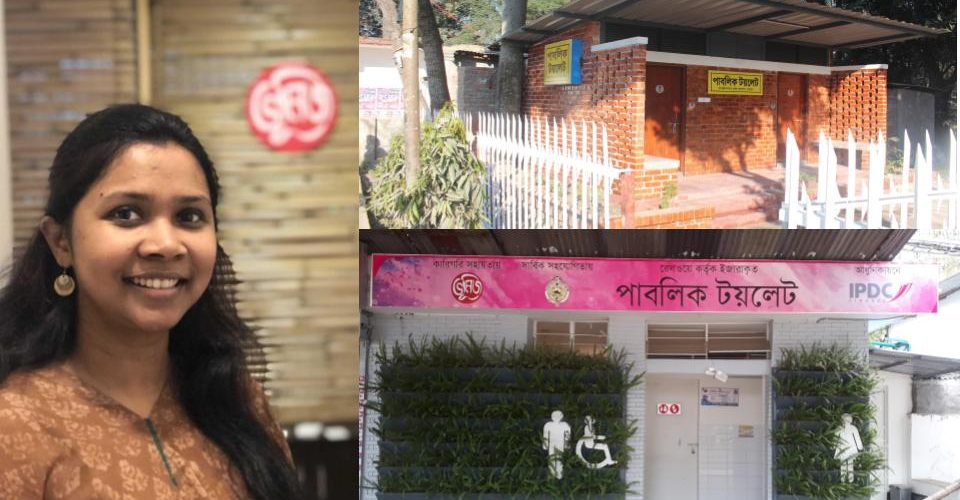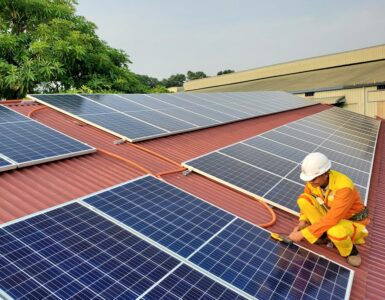If you meet an architect, what would you expect?
Plan and design fancy houses & buildings, multistories, commercial complexes, skyscrapers, apartments, schools, government offices, etc.
Well, not everyone is the same. There are a few who architect a future.
Farhana Rashid Bhumijo is one such name.

Farhana is an architect by profession & training, but instead of taking the typical role of architecting a building, she is architecting a future – a better future for people in Bangladesh.
Entrepreneurs discuss solving a problem, but very few start on an issue that is common across the globe, especially in developing & underdeveloped regions of the world – finding a clean & hygienic place to attend nature’s call – TOILET.
If you are a woman, the problem is even more severe; the mother will ask their daughters to drink less water to spare the plight of finding a toilet.
Farhana Rashid has decided to change this mindset so that her daughter and no other daughter have to go through the same turmoil. She decided to start Bhumijo in Bangladesh – the eighth-most populous country in the world and one of the fastest-growing economies in Asia.
But, like many developing and populous countries face a massive shortage of clean, safe & hygienic toilets.
Farhana Rashid Bhumijo is into Public Toilets space, providing sanitation services. Considering an architect is involved, the company ensures the toilets are comfortable and convenient for its users.
Here is an edited version/excerpt of our conversation with Farhana.
Bhumijo is an interesting name!!
Bhumijo is a Bengali word and it means something that has evolved from Earth. So, it is nothing related to the toilet.
I am an architect by profession, and then did my master’s in sustainable urban planning and design. The thought of naming the organization ‘Bhumijo’ came from the fact that my profession demands creating something out of the earth; thus, the name reflected that. Furthermore, it was also about acting responsibly in anything that we do.
Why Toilet, not many start their entrepreneurial journey with Toilet
The toilet initiative started very early on in my life. As a woman, I realized we did not have good public toilets anywhere. We all faced this – me, my mother, and so many other girls.
But we never spoke about it. It was as if we were taking it for granted. Whenever we went outside, it was very common for us to drink less water, or if we used to take water while going out, we were told not to have too much water and this is a prevalent story among women.
Shortly afterward, I learned that one of my aunts passed away due to recurrent UTI and kidney failure. That is when I decided I needed to work on that and could not give up. I kept thinking of an idea to help solve this problem to create a well-maintained, better quality, healthy, and hygienic toilet across the country.
What was the journey like
There was this competition called the Urban Innovation Challenge which BRAC organized at the end of 2016. We submitted our idea and we got the funding.
Initially, the idea was that we could do it, it can be done – that stage. But after getting the seed money, we translated our concept into reality. It was a women-only toilet at that time.
Within six months, it was operationally breakeven. That was another milestone for us. And right now, we have seven operational toilets.
Our services now include designing where the public toilet should be and how it should be. We also do the planning and designing, how the construction should be, and most importantly, the operations and maintenance. While we operate around seven public toilets, we have designed over 15 toilets nationwide.
So is it like you provide consulting services to others who want to construct a public toilet?
Yes, we do. We do research related to toilets. Also, provide architectural and engineering design and support for construction. It could be different agencies like city corporations, government agencies like railway stations, or other private organizations that want to contribute to this sector and some NGOs.
Most public toilets we operate are owned by other agencies like city corporations or market authorities that own those we use in markets.
What is the business model like? How do you ensure sustainability?
We charge some money, and the fees are of two different types. One is a subscribed user and the other one is a pay-per-use user. At the same time, we also have some other things available at the facility, like drinking water, washing facilities, hygiene facilities like diapers and sanitary pads, etc.
So it is related and is very contextual depending on some things which are needed at some place while it may not be available at the other.
What were the initial challenges that you faced?
Building something new is not uncommon but maintaining it with very good quality is uncommon in Bangladesh. Initially, people thought it would go back to the previous conditions like the typical toilets already existing in the country.
Maintaining the hygiene and health of the toilets simultaneously and making them operationally sustainable to ensure that we do not have to put much money from our pocket has been the focus. The response has been good so far. Initially, people thought that women-only toilets wouldn’t work.
The public toilets are not seen to be viable from a business perspective. They are seen more from the NGO lens wherein you donate or it runs via grant or CSR.
How is your experience working with the government authorities? How easy or difficult is it to find space for toilets?
Our initial proposition was not to build an entirely new toilet. When we started, we found from our initial research we found that there were a lot of underutilized toilets which are not in good condition. So our idea was to make them operation-wise sustainable and a place people can go to without hesitation.
Dhaka is very crowded and also most of the urban places are very crowded. Finding a piece of land is not that easy. And hence the thought of using a toilet already in a good location and has excellent accessibility.
At first, we visited some places and developed some findings or metrics like how many people are using the toilet or what are the basic metrics of that location or the mix of the people (age) or how many times are they using it or what is the duration of their stay or what’s the purpose. So, if there is an existing toilet, our priority was to check if working with that building and with that agency is possible. If nothing was available, our next option was to build a new facility.
Working with the government ultimately depends on the Mayor – if (s)he is a visionary. We are working with a few visionary Mayors who are taking good initiatives and having a good day on public sanitation. Overall, our government is taking it very seriously right now.
How do you operate the toilet? Do you use technology? Or do you provide the manpower to facilitate operations?
It depends on the location. In some places, using technology does not cover the initial rudimentary cost of operations.
We operate in two ways;
- In some toilets, we are doing everything from providing manpower to tissue paper and cleaning – everything.
- Then there is one wherein we provide just the supervision regarding quality since there is another agency, and we train them and check if they are maintaining quality.
In terms of technology, we are still working on it and in the next few months, we are building five new public toilets in bazaars in Dhaka. Within these new facilities, we will have new technologies incorporated, like different sensors and access control.
What is the average footfall in the toilets that you operate?
It varies from facility to facility but on average, it is around 400 to 500 per day.
What has the feedback been like?
The reaction is good. So far our usage is around 400,000 times people have used our toilet, out of which 160,000 are women, and so far, they are satisfied. Hopefully, by using proper technology, we could increase the satisfaction level.
How are you coping with the COVID situation?
The toilets were in public spaces, like in the park or the railway station where the trains were not being operated. Hence the operations were stalled for a few months. But now it has partially opened.
However, the community toilets operated full-time even during the lockdown period. Also, the need for hygienic and good-quality toilets increased in these areas. During this time, our team also worked on developing a manual touchless system for using toilet paper to minimize the risk of contact.
In our country’s current scheme of things, based on the existing infrastructure, you cannot change everything and it takes time.
The adoption of new technology takes time. We have also worked with other technologies which are low tech but we have already installed them. The touchless solution has been installed in hospitals as part of our COVID response for health professionals.
You were also like a CoVID warrior. So what are Farhana Rashid Bhumijo’s plans?
Just a few days back, we completed our business projection and as per our calculation, we are planning to build and operate almost 100 public toilets in the Dhaka region. That’s our current plan and within next year, hopefully, we will go for the next round of investment or co-investment.
What inspires you
I have a daughter and want my daughter, or any daughter, not to worry about drinking water and sanitation. That’s the main inspiration and I hope within a few years the problem won’t exist at all.
You have written that you are known as Toilet Aapa or Toilet sister, right …
Yeah, I have been trained as an architect and some people were like – what are you doing being an architect? You are not designing high-rise buildings – those fancy things.
The public toilet problem exists in many different parts of the world. We are sure this can be taken to any part of the world. We at Change Started wish Farhana Rashid Bhumijo great success in architecting a company that reaches heights taller than any skyscraper.






Add comment